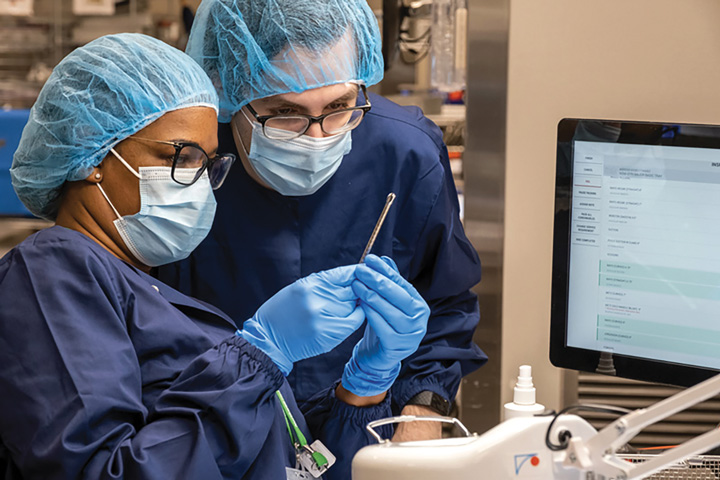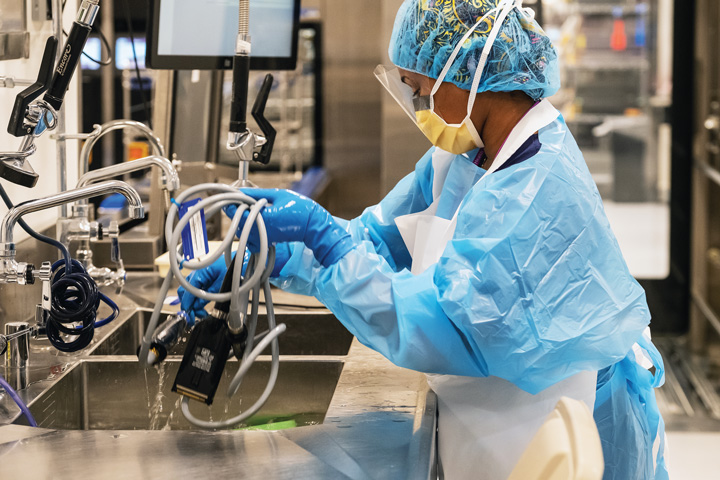- Home
- The Magazine
- Article
How Clean Are Your Surgical Instruments?
By: Joe Paone | Senior Editor
Published: 4/5/2023
Sterile processing leaders offer key insights on what they use to confirm and improve sterility.
Just because an instrument has been reprocessed doesn’t mean that it’s clean.
In some cases, that’s because reprocessing techs are rushing and forced to sometimes cut corners behind the scenes as the daily crush of the OR schedule begins to back up.
“The numerous patients treated per day in ASCs can lead to a need to turn over instruments rapidly and rush or skip steps, which poses a risk of improperly processed instruments,” says Densley Coke, MBA, BSHM, CST, CRCST, CHL, CER, central sterile processing manager for Northside Hospital-Forsythe in Cumming, Ga., and a director on the Board of the Healthcare Sterile Processing Association (HSPA), which represents sterile processing professionals worldwide.
“Some ASCs attempt to keep costs down and add to productivity by reprocessing instruments used in previous cases for their next case on the schedule,” says Mr. Coke. “This makes it difficult for sterile processing staff to process these instruments thoroughly. If instruments are not properly cleaned and sterilized according to manufacturer’s instructions for use (IFU) and best practices, the patient can develop a surgical site infection.”
However, even ASCs that act responsibly with scheduling to ensure their reprocessing techs aren’t rushed may not truly know how clean their reprocessed instruments actually are. That’s where cleanliness verification tools come in.
Savvy facilities and their sterile processing leaders are using technologies like chemical indicators, biological test strips, borescopes, lighted magnification, water testing and instrument-tracking systems to make sure their instruments truly are clean. In turn, they gain much higher assurance that those instruments are safe to use on their patients.
Tools of the trade

We recently spoke with four HSPA leaders about what administrators and their sterile processing techs should consider to get a better handle on how clean the instruments they use every day actually are.
• Verification tests. Monique L. Jelks, MSOL, BA, CRCST, clinical educator, sterile processing, with WellStar Health’s Cobb, Vinings, Paulding and Douglas Hospitals in Georgia, and incoming president of HSPA’s Board of Directors, says that when it comes to instruments that facilities think are clean but sometimes aren’t, flexible endoscopes are the most common culprit. “Flexible endoscopes are at the top of the list simply because there is no way to visually inspect the channels of the very long insertion tube,” says Ms. Jelks.
Mr. Coke says it is important to verify the cleanliness of surgical instruments before they are reprocessed. “Even after washing and disinfecting, it is difficult to verify cleanliness when the primary means of verification is the naked eye,” he says. “This is where adenosine triphosphate (ATP) testing is helpful.
Mr. Coke says various brands of tests are available that use microbial culture swab assessment, which can detect residual blood or protein that remains on instruments after cleaning. “These kits are disposed of after use and, in most cases, don’t require refrigeration or costly equipment,” he notes.
• Lighted magnification. To inspect complex instrumentation where biological debris may be hiding, Ms. Jelks says ASCs at the very least should invest in large, lighted magnifiers for the assembly station in the sterile processing department where final inspection of instruments takes place. “The lighted magnifier allows the technician to critically inspect areas of the surgical instrument that cannot be seen with the naked eye, confirming the cleanliness of the instrument,” she says.
Ms. Jelks says verifying the cleanliness of flexible endoscopes should be a particularly high priority if they are used at your facility — especially if you don’t have an automated endoscope reprocessor (AER) on hand. “Many ASCs are high-performing endoscopy facilities with a high turnover for endoscope reprocessing, but without an AER,” she says. “Having a verification test can help ensure scopes are clean, and patients are safe.”
• Borescopes. Mr. Coke says that while a borescope costs more than ATP testing and lighted magnifiers, it builds further on the effectiveness of those tools. “A lighted magnifier cannot expose instruments with lumens, such as suction cannulas,” he says. “A borescope is a semi-rigid fiber optic device that has an inspection camera so processing technicians can look into small cavities and spaces of surgical instruments.”
The use of a borescope is not only extremely helpful to verify the cleanliness of endoscopes and other complex surgical instruments but is now recommended by the updated ANSI/AAMI ST91 endoscope reprocessing standard. “Using a borescope for inspection, one can find surgical instrument lumens with post-sterilization biological remains such as blood, bone, tissue and rust, as well as damage to instruments that was unable to be detected otherwise,” says Mr. Coke. He adds that advanced borescopes are equipped with a camera and video technology that can be useful for compiling data for reporting.
Tony Thurmond, CRCST, CIS, CHL, FCS, sterile processing manager at Dayton (Ohio) Children’s Medical Center, HSPA past-president and current director on the HSPA Board, notes that borescopes aren’t just important for inspecting endoscopes. “It is critical to have a borescope to visualize cannulated devices, and we are starting to see more IFUs that require their use,” he says. “For example, an arthroscopy shaver whose IFU calls for a visual inspection of the inner cannula can have tissue debris stuck inside. Without a borescope to inspect the inside of the device, it could go several uses before ever being identified. That poses serious infection risks for the patient.”
• Instrument-tracking systems. Mr. Thurmond says ASCs that do not have an instrument-tracking system that interfaces with their operating room scheduling system may face efficiency difficulties. Without that integration, the chances that instruments won’t be available for procedures, or that some instrumentation is rushed back into service, perhaps by skipping steps in reprocessing, grows.

“Many ASCs are challenged with not having enough instrumentation, which may lead them to do quick turnovers of instrument sets to meet scheduling demand,” he says. “It is essential to know the number of trays and instruments you have in inventory and the amount that are needed to maintain the level of procedures on your schedule. All instruments used in patient care need enough time and resources to be processed thoroughly, consistently and according to IFUs, standards and best practices.”
• Water quality. Ms. Jelks says ASC sterile processing departments should perform tests to ensure water quality and temperature are aligned with the detergent manufacturer’s IFU. “ASCs are often standalone facilities that do not have the sophisticated machines and monitoring equipment of hospitals,” she says. “A water quality test would surprise most administrators. Water testing will confirm the presence of hard water, which prevents detergents from breaking down contaminants. If poor water quality is discovered, there could be a huge cost associated with obtaining a filtration system.”
• Ambient lighting. Damien Berg, BS, BA, CRCST, AAMIF, HSPA’s vice president of strategic initiatives, says one simple and easy-to-use “tool” to verify instruments’ cleanliness that is often overlooked is the lighting in the sterile processing department. “Outfitting sterile processing areas with proper lighting allows the technician to visually inspect the instruments in decontamination and across other stages of processing,” he says.
• Robotics consideration. With a growing number of robotic surgical systems turning up in ASCs, reprocessing techs face a demanding and precise task in keeping them clean. “ASCs need to know that the time it takes to manually clean robotic arms is extensive,” says Ms. Jelks. “Therefore, the capital purchase of a thermal disinfection machine for robotic arms is necessary to ensure the efficiency of cleaning and disinfection prior to sterilization.”
Making it stick
Mr. Berg characterizes the question of how to verify the cleanliness of surgical instruments as complex and evolving. He also reminds ASC leaders who are tackling this issue not to focus exclusively on the verification products and systems available. “The first approach I would take would be to verify your policies and practices around decontamination,” he says. “Train your team and then test using different products and methods that will show that the team and equipment are doing what they need to do for patient safety.”
Ms. Jelks says that whatever new tools your sterile processing department will employ, lean on the tools’ vendors and distributors to make sure your reprocessing techs fully understand how to use them properly.
“The best way to provide education is by way of the distributor’s educational offering,” she says.
“Sometimes this is an additional cost. However, a one-time training session, along with an identified champion user of the product to continue the education annually for the ASC’s sterile processing technicians, would help retain knowledge.”
Overall, experts advise that ASCs, which generally have far fewer institutional guardrails and redundancies in place than hospitals, need to prioritize instrument cleanliness — and thus, patient safety — as much as they do procedural volume and growth. They also encourage ASC administrators and leaders to invest in the knowledge and skills of their reprocessing techs as much as they do the cleanliness verification tools they are using.
“I believe some ASCs are falling short here simply due to the lack of knowledge about how proper, thorough, standards-based reprocessing is achieved and the push to do more surgeries, which puts patients at risk for harm,” says Ms. Jelks. “ASCs can improve by learning more about regulatory and industry standards that help to keep patients safe. They also should invest in their sterile processing technicians by providing educational opportunities, including participation in local and national conferences, to obtain and maintain knowledge of current processes.” OSM
.svg?sfvrsn=be606e78_3)
.svg?sfvrsn=56b2f850_5)